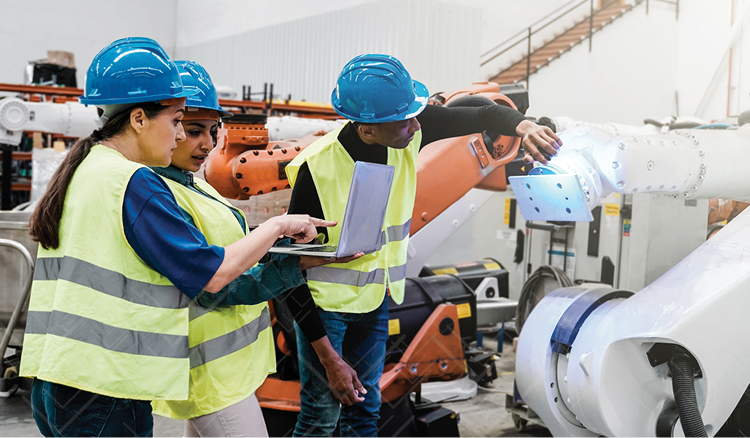Automation Alone Won’t Save You: Why the Smartest Companies Are Pairing Machines with On-Demand Labor
From robotic assembly lines and automated storage systems to sensor-driven material handling, the world’s most competitive companies are all-in on automation. It has transformed manufacturing and logistics, delivering speed, precision, and efficiency at a scale that was once unimaginable. But after years of investment, many leaders are confronting a hard truth: automation alone cannot deliver the adaptability that modern markets demand.
You can automate every process in your operation and still miss deadlines, underutilize equipment, or lose ground to competitors. Efficiency is not agility. Machines can execute perfectly, but they typically cannot flex to absorb unpredictable demand or sudden disruptions. Automation can optimize production, but it can't balance it.
That’s why companies are increasingly adopting on-demand labor as a workforce strategy to complement automation. Veryable's on-demand labor platform connects companies with independent operators through a digital marketplace, enabling a flexible, just-in-time extension of their workforce. By integrating this strategy into their operations, companies gain the ability to scale labor capacity in real time, align headcount precisely with demand, and roll out automation initiatives more effectively.
The future will not belong to the company with the most robots, it will belong to the company that can make automation and on-demand labor work together to build a truly adaptive operation. In this article, we’ll explain how and why.
Automation is Powerful, But It’s Also Rigid
Automation delivers remarkable efficiency: robots don’t tire, algorithms don’t lose focus, and sensors do not call in sick. Yet most automation systems are engineered for consistency—they presuppose stable inputs, steady volumes, and predictable workflows.
In today’s environment, that level of stability is rare. Customer expectations shift overnight, product mixes evolve constantly, and supply chains fluctuate unpredictably, placing intense pressure on production schedules and capacity planning. Under those conditions, an automated system can only perform as well as its surrounding ecosystem allows. When demand spikes, machines cannot instantly scale; when production adapts, reprogramming or retraining takes time; when the unexpected happens, automation on its own may fall short. Without flexibility within a company's labor strategy, automation can become an efficient bottleneck.
A workforce strategy built around on-demand labor offers the real elasticity automation demands by enabling companies to scale labor capacity in real-time. This alignment keeps production, fulfillment, and service tightly synchronized with actual demand.
Five Ways On-Demand Labor Complements Automation
1. Bridging the Implementation and Ramp-Up Gap
No automation project moves from installation to full performance immediately. Integration, testing, and operator training all take time, while customer demand never slows down to accommodate new systems.
On-demand labor fills that gap. Instead of overburdening full-time team members or paying excessive overtime, companies can bring in skilled operators temporarily to sustain throughput during installation and optimization. Once the system stabilizes, they can reduce labor capacity just as quickly, creating a seamless handoff between manual and automated productivity and accelerating the return on investment.
2. Maximizing Utilization and Reducing Idle Time
Automation only drives value when it’s running. A robot that’s idle because no one is available to load, monitor, or inspect materials represents underused capital. On-demand labor keeps automated assets productive by supplying the right number of operators for every shift, product changeover, or short-term surge.
When demand slows, that capacity scales back immediately. This alignment of labor and machine utilization turns automation from a fixed investment into a truly responsive resource.
3. Managing Demand Volatility Without Overstaffing
Demand rarely follows a predictable curve. Traditional staffing models force a choice between carrying excess labor to handle peaks or risking missed orders when volume surges.
On-demand labor eliminates that tradeoff. With automation managing base-load production, the core workforce can focus on oversight and continuous improvement, while on-demand operators handle short-term increases in packaging, inspection, or material movement. When demand drops, that variable labor capacity flexes down. The result is a leaner cost structure and consistent productivity across all demand scenarios.
4. Supporting Continuous Improvement and Maintenance
Even the most advanced automation requires regular tuning, maintenance, and process improvement. Each of these activities can temporarily disrupt output. On-demand labor provides instant capacity during these cycles, allowing companies to maintain production while core team members focus on optimization, upgrades, or preventive maintenance.
This approach keeps core teams focused on value-add work while preserving operational flow—a key advantage for facilities that prioritize continuous improvement.
5. Complementing Automation with Human Judgment and Adaptability
Automation performs flawlessly within defined parameters, but it still struggles with variation—unexpected materials, custom orders, last-minute changes, or minor system faults.
On-demand labor strengthens the adaptive layer around automation, ensuring there’s always capacity to handle exceptions, rework, or non-standard tasks. This combination of precision and flexibility makes operations more resilient and responsive in the face of change.
Why Future of Operations
Automation and on-demand labor are not competing strategies; they are complementary forces. Automation drives efficiency, while on-demand labor ensures that efficiency translates into agility. Together, they create operations that can flex with the market, respond to change in real-time, and maintain throughput no matter what.
The smartest companies are not just automating, they are building operational systems that adapt as quickly as demand changes. They understand that technology alone doesn’t create agility. By integrating on-demand labor as part of their workforce strategy, these companies unlock the full power of their automation investments and secure a lasting advantage in the next era of production.
Leadership Imperatives for the Automated Era
For executives leading automation initiatives, the lesson is clear: technology alone doesn’t create agility. Automation delivers efficiency, but only when it’s paired with a workforce strategy built to move at the speed of demand.
On-demand labor connects the two worlds. It allows companies to flex their workforce in sync with their technology — scaling up to capture opportunity, and scaling down to protect efficiency.
Leaders who integrate automation and on-demand labor aren’t just optimizing processes; they’re future-proofing their operations. They’re building systems that flex instantly, recover faster, and adapt continuously to change.
The next industrial era won’t be defined by replacing labor with machines, but by linking them into one adaptive, responsive system — where technology and labor move as one.
Get Started
👉 Take the first step by Creating Your Free Business Profile
👉 Want to speak to an expert? Contact us today
Previous Posts
How On Demand Labor Helps Manufacturers Maintain World Class Quality When Demand Refuses to Sit Still
The Future of Manufacturing and Logistics
Create a free business profile today to explore our platform.






